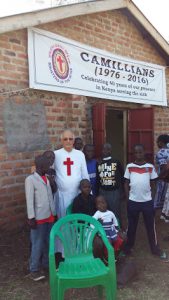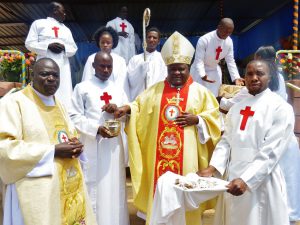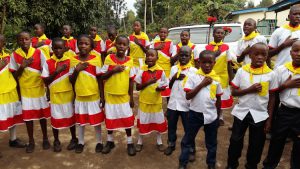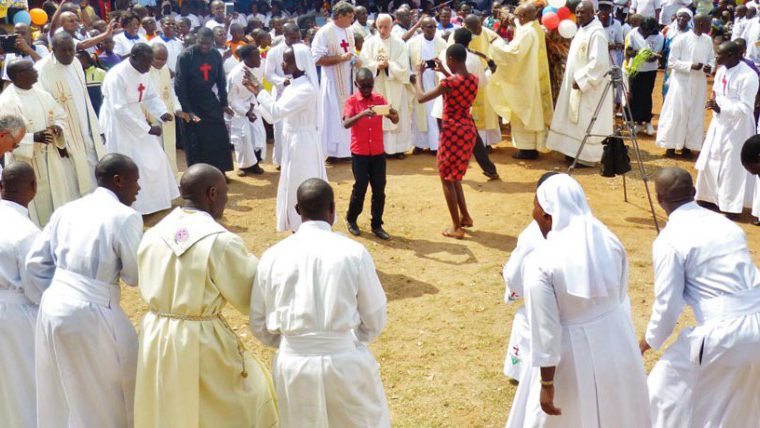 It is natural that Tabaka is the place where the Camillians of Kenya celebrated the fortieth anniversary of their arrival in the country. Even though the Camillians are by now present in various other localities, Tabaka always comes to mind when reference is made to our mission in this African country of East Africa. It is no accident that an article of 2003 published in the review Misssione Salute (‘Mission Health’) defined Tabaka as ‘the firstborn’.
It is natural that Tabaka is the place where the Camillians of Kenya celebrated the fortieth anniversary of their arrival in the country. Even though the Camillians are by now present in various other localities, Tabaka always comes to mind when reference is made to our mission in this African country of East Africa. It is no accident that an article of 2003 published in the review Misssione Salute (‘Mission Health’) defined Tabaka as ‘the firstborn’.
The date 15 August 1976 has been established as the official day of the foundation, even though various Ministers of the Sick of the then Province of Lombardy and Veneto had already set foot in Tabaka for varying periods of time to explore the terrain for the establishment of our work. This terrain was in fact a hospital that had already been built a few years previously by the German Misereor in the parish area of Tabaka, in the diocese of Kisii. This is not the place to go over its history, piece by piece, starting with the long negotiations between Monsignor Ercole Brocchieri (of the diocese of Cremona) and Fr. Forsenio Vezzani (of the Province of Lombardy and Veneto). The details of it can be read in the easy-to-read book by Fr. Giovanni Bonaldi, I Camilliani in Kenya da 25 anni (‘The Camillians in Kenya for Twenty-five Years’, Verona, 2001).
The Hospital was Opened and Closed Twice
The Bishop of Kisii, Msgr. Joseph Mairura Okemwa, who presided over the concelebration of the Eucharist for this anniversary, which took place in Tabaka on 6 August 2016, said that we must give thanks to the Lord if today we can celebrate the fortieth anniversary of the foundation. This was because had we relied only on our own forces this foundation would not have had a future because at the outset the Hospital of Tabaka on two occasions was opened and then closed because it was simply not possible to carry on! It naturally comes to mind that exactly the same thing happened to another foundation – that of our Order – when our Founder, St. Camillus de Lellis, discouraged by the constant failures and the opposition to it, would have been on the point of throwing in the towel had it not been for the fact that Christ on the Crucifix separated his arms from the cross and said to him in fatherly tones: “Camillus do not be troubled; this little plant will grow because it is my work and not yours!”
Despite the vicissitudes and difficulties that still afflict us, it is possible to assert that the Delegation is going through a stage of continuous development. This is because, if we engage in a brief glance at what has been going on recently, over the last year or so we have witnessed the opening of a new parish, four priests have been ordained, and four new professed have been accepted.
Two Pioneers who are still in the Field
But let us return to the celebrations of 6 August. Standing on the altar for the celebration of the Eucharist, around the bishop and the Provincial Delegate, Fr. Aloice Ocher, were Father Francesco Avi and a little distant from him Brother Albano Balzarin, two pioneers of the foundation, the only religious to still be in the field, given that the others have gone back to Italy, for example Fr. Francesco Spagnolo and Fr. Mario Cattaneo. Some of the other creators of Tabaka have migrated elsewhere (for example Fr. Emilio Balliana, to Karungu, and Fr. Giuseppe Proserpio, to Tanzania). All of them helped to construct that mosaic of charity made up of so many pieces, which we can identify as being works of mercy, a subject this jubilee year leads us to reflect upon. To this brief and incomplete list of witnesses who are still alive, we should add a list that is longer. Unfortunately, this is a list of witnesses who have crossed the bar, religious who contributed in a decisive fashion to the foundation of Tabaka and to the subsequent development of its offshoots: Fr. Pio Rizzi, Br. Giuseppe Confalonieri, Br. Fabio Zeni, Fr. Rino Meneghello, Br. Valentino Gastaldello, Fr. Gian Marco dal Bon, Fr. Pierino Cunegatti and – most recently – Fr. Stephen Kavita and Fr. Richard Mutuku, two Kenyan Camillian religious who died in a road accident.
At the beginning of the celebration the present director of the hospital, Fr. Julius Morara, read out a historical excursus on the last forty years of the mission in Kenya and emphasised the contribution of the various institutions mentioned above, namely the diocese of Cremona, the diocese of Kisii, the German Misereor, and Italian Caritas. He also referred to the moral and pastoral support of the bishops who had followed one another in governing the diocese of Kisii: Msgr. Otunga, Msgr. Mugendi, and the current bishop, Msgr. Mairura. Fr. Morara did not fail to mention the contrasts and the misunderstandings that had taken place, for example between the medical and the administrative authorities, which reached such a point as to halt the provision of services by the hospital. However, these difficulties and halts did not stop things because the strong wish to continue expressed by the mother Province, and the readiness to help demonstrated by the men and women religious, always managed to prevail.
Brother Albano Returns to Italy for Good after Forty Years of Missionary Life
 Various individuals followed one another on the stage to offer their congratulations or express their gratitude, all of whom had been invited to do so with savoir faire by the master of ceremonies, Fr. Samuel Oleck. Amongst them were the Superior of the Sisters of the Blessed Virgin, Sr. Giovanna Moraa; the present administrative director, Brother Joseph Khiyaniri; two Assistant County Commissioners; the Director of Public Health; the representative of the Kisii branch of the NHIF insurance company; and yet others such as Fr. Francis Mose, the curate of Suneka, who gave a homily in response to an invitation by the bishop. The third person to speak was Brother Albano Balzarin who in addition to offering his thanks also took advantage of the occasion to say goodbye to everyone because in a few days’ time he would be leaving Kenya for good after forty years of missionary activity in the hospitals of Tabaka and Karungu. His speech provoked a chorus of Wololooo (an interjection he often uses) by those who were present and this was a testimony to his popularity and to the good character for which he is remembered after all his years of service in Tabaka and Karungu.
Various individuals followed one another on the stage to offer their congratulations or express their gratitude, all of whom had been invited to do so with savoir faire by the master of ceremonies, Fr. Samuel Oleck. Amongst them were the Superior of the Sisters of the Blessed Virgin, Sr. Giovanna Moraa; the present administrative director, Brother Joseph Khiyaniri; two Assistant County Commissioners; the Director of Public Health; the representative of the Kisii branch of the NHIF insurance company; and yet others such as Fr. Francis Mose, the curate of Suneka, who gave a homily in response to an invitation by the bishop. The third person to speak was Brother Albano Balzarin who in addition to offering his thanks also took advantage of the occasion to say goodbye to everyone because in a few days’ time he would be leaving Kenya for good after forty years of missionary activity in the hospitals of Tabaka and Karungu. His speech provoked a chorus of Wololooo (an interjection he often uses) by those who were present and this was a testimony to his popularity and to the good character for which he is remembered after all his years of service in Tabaka and Karungu.
Fr. Avi then took the floor. He is the current Superior of the community of Tabaka and for very many years he was the health-care director of the hospital. Even though he celebrated his eightieth birthday a few years ago, he still dedicates himself with total devotion to the needs of Tabaka. Amongst the many things that he said, he was keen to make clear that the anniversary of that day was not a commemoration only of the foundation of Tabaka. There were also the offshoots that Tabaka had produced, that is to say the other three communities of the Delegation – those of Bolech House, of the seminary and of Karungu which work at various levels in other localities in Kenya.
A Holy Mass that Lasted Five Hours
Lastly, the Provincal Delegate Father Aloice thanked the bishop and the large number of volunteers who over the years have worked – at times for many consecutive years – at the side of the religious (to give just one example the married couple, Aldo and Mariarosa Cassata). Especial thanks were extended to the Camillian Sisters, the women Ministers of the Sick, who since the outset (we may remember in particular Sr. Maria Grazia, Sr. Emilia, Sr. Veronica, and Sr. Anastasia) have contributed in a decisive way to the growth of the hospital. Gratitude and joy were expressed to the large number of guests who had come for the occasion. Some of them had come from Nairobi, travelling during the night by coach and then returning to the capital city by coach, once again during the night.
The celebration of the Eucharist lasted for five hours. It began at 11.00 and finished at 16.00. Lunch was offered to everybody and began at 16.30. Two cows had been slaughtered for the occasion. On the stage prepared for the Holy Mass everything happened. But, of course, nothing that was prohibited! Only many ‘colourful’ things that in a Western context would provoke at the least wonder and surprise. For example, the fact that amongst the offerings taken to the altar was a live ram which the bishop had blessed by making the sign of the cross over its head. At the end of the Holy Mass all of the concelebrants – about twenty men in all – danced together, a number of times going round in a circle in front of the stage, moving their sides and arms without any inhibitions. And – this was the cherry on the cake (this is indeed the right phrase) – at the end of the Holy Mass the cake for the fortieth anniversary was blessed by the bishop himself. The cake was then cut and served to all of the celebrants who were sitting around the altar dressed in their holy vestments.
Recent Developments: the Delegation in Figures
 After 15 August 1976, the day of its birth, the foundation of Tabaka was soon transformed into a Delegation. More specifically, this took place officially in the year 1987 with Fr. Gian Marco Dal Bon as the first Provincial Delegate; however, as early as 1978 Fr. Rino Meneghello had settled in Nairobi as the Procurator of the mission.
After 15 August 1976, the day of its birth, the foundation of Tabaka was soon transformed into a Delegation. More specifically, this took place officially in the year 1987 with Fr. Gian Marco Dal Bon as the first Provincial Delegate; however, as early as 1978 Fr. Rino Meneghello had settled in Nairobi as the Procurator of the mission.
After forty years of activity in various fields, such as the health-care field (hospitals); the field of pastoral care (chaplaincies); the field of formation (the seminary); and the field of parishes, the Delegation has thirty perpetual professed (of whom twenty-seven are priests and three are brothers); sixteen temporary professed (theology students); and twelve postulants (students of philosophy). There are four communities: at Tabaka, founded in 1976 in the diocese of Kisii; at Bolech House, which was created in 1979 in the archdiocese of Nairobi; at the St. Camillus Seminary, which was opened in 1986 but which was constituted as a community a few years later; and at Karungu, which was opened in 1993 in the diocese of Homa Bay.
In Tabaka in the 1990s a famous school for nurses was created. In Karungu, in addition to the hospital, a family house for children with HIV was established and there is also the novitiate, the Blessed Tezza Complex for elementary and secondary schools, and a Catholic bookshop. At the beginning of this century, the community of Bolech House created a centre for pastoral care in health which to begin with was located in a building that was rented. Now this centre is a part of a new building which has only just been finished and which has taken the place of the old Bolech House, a farmhouse dating from the 1950s which has been demolished.
In 2012, the Delegation accepted a new kind of pastoral activity and agreed to administer the ‘Our Lady Help of Christians’ Parish in Ndundu, in the archdiocese of Nairobi. In 2014, the diocese of Homa Bay entrusted to us the St. John the Baptist Parish in Rodi Kopany which is located between Tabaka and Karungu and which at a juridical level belongs to the community of Tabaka. In 2015 the Delegation accepted the invitation of Cardinal John Njue of the archdiocese of Nairobi and agreed to take on another parish, St. Peter’s Parish, which is fifteen kilometres from the capital in the town of Ruiru. Both this parish and the parish of Ndundu are run by the community of Bolech House. Four other chaplaincies belong to this community. Three of them are hospital chaplaincies (at the Nairobi Hospital, at the St. Francis Community Hospital, and at the Mater Hospital) whereas the other is the chaplaincy of the Mount Kenya University in Thika.
The next step to be taken is the juridical move from being a Delegation to being a Vice-Province, and this is already being worked on. In the meanwhile, in recent days four young temporary professed, after ending their year dedicated to pastoral care, made a formal request to make their perpetual professions: this decision has infused courage in all of our hearts to proceed with enthusiasm – and with their direct contribution – along the pathway that was begun some forty years ago.
Paolo Guarise















Camillians on Facebook
Camillians on Twitter
Camillians on Instagram